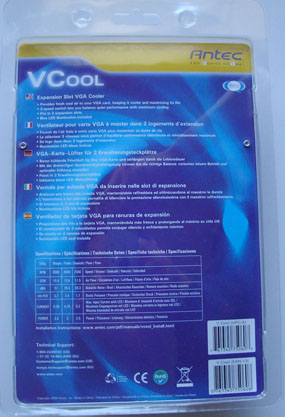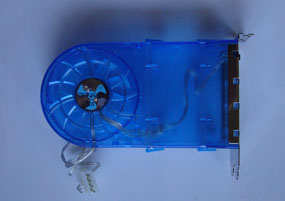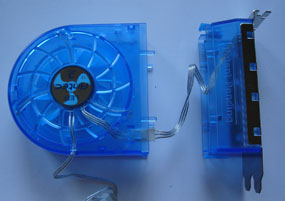Antec VCool provides a simple solution to those who want to keep their video card cool but do not want to mess with the existing HSF. It uses two expansion slots next to the video card and blows cool air to the video card. How does this cooler performs? Can it help to keep the system cool while keep the noise level down? Check out our review and see if this is a good option for you.
Introduction
While the processor is getting cooler, the graphic card is just keep getting hotter and hotter. In order to bring out the needed performance, both ATI and NVIDIA’s high end graphic cards not only consume quite a lot of power, they also produce tremendous amount of heat. Under poorly ventilated system, the cards can even reach as high as 100 degree Celsius under load. Keeping graphic cards cool has become a challenge to many people as it is a balance between keeping the cards cool and the noise level down. Many people have resorted to water cooling or mount an after market fan to the VGA, but both of these methods require some tinkering with the physical hardware, which in some cases would void the warranty of the video cards. Today, we will be looking at a third solution that would assist cooling of the video cards without tinkering the cards, an video card cooler from Antec—VCool.
Antec is a very well known computer peripheral company in the industry. They are probably best known for their excellent power supplies and some nicely designed cases. Many people may not aware that in addition to these products, Antec actually sells a lot of other peripherals, ranging from coolings to some computer accessories. The VCool that we are looking at today is one of the products from Antec that is designed to help cool the components inside a system. Let’s see how this little cooler performs.

Let’s start by looking at the features of the card
Features:
- Provides fresh cool air to your VGA card, keeping it cooler and maximizing its life
- Keeps your graphic cards 5 to 15 C cooler for maximum performance
- 3-speed switch lets you balance quiet performance with maximum cooling
- Fits in 2 expansion slots
- Blue LED illumination included
Closer Look
The package comes in a plastic casing that clearly shows the fan. VCool, as the name implies, is a video card cooler. It is designed to take two expansion slots on the back of the system. The fan is a simple design, basically it blows cool air into the graphic card. As oppose to many other graphic card coolers, which require removal of existing graphic card’s HSF in order to replace it, Antec’s VCool simply mounts next to the graphic card, so no need to remove the existing cooler. Hence, the installation is extremely easy, just simply screw the VCool onto the case and voila, it’s installed.
The VCool is powered with 4 pin molex. The cooler comes in three parts: the fan, the extension tube, and the intake section. The extension tube is not preinstalled. Antec designs the cooler with extension tube so that it can extend the fan farther into the system to cool the longer graphic cards. Without the extension, the center of the fan is about 3 inches from the side of the intake tube, with the extension installed, it is about 4 ¾ inches from the side of the intake tube. The fan is about 3.54 inches(90 mm) in diameter, but the actual blade is only about 2.36 inches (60 mm) in diameter. If you need to use the extension tube, carefully squeeze the two sides of the unit (where the tabs are) and pull the unit apart (you would have to be careful not to rip apart the fan connector inside the unit). Unplug the fan, attach the extension tube to the intake section, then attach the cable to the fan, and attach the fan unit. Notice that on each unit, there’s two little feet on each side of them to guide you to connect the units, be careful with them as they are small and could break easily.

The cooler has three speed settings for the fan: 2,500 RPM (low), 3,000 RPM (middle), and 3,500 RPM (high). The control for the fan settings are on the outside of the intake tube with a little tab. User can adjust the fan setting by simply change the switch. In addition, VCool comes with blue LED, so for those who got a side panel, it will emit blue glows, pretty neat.
Installation and Testing
Since VCool just sits next to the video card, this means that it will work with all system, SLI, Crossfire, the new 7950GX2 (two cards into one), or any sinle card systems. The installation of VCool is extremely simple. Simply place it next to the video card and connect the power connector then it’s done. It would have be sure that you have two spaces free next to the video card for it though.
I put the VCool next to my Gigabyte 7800GT graphic card (review). The card is running at stock speed. I ran 3dmark06 three times to push the card. Each test is done at an interval of 10 minutes break to allow the video card to cool. The temperature is recorded using Everest 3.01.679. Since my Gigabyte 7800GT has the tunnel-like heatsink and fan that covers the whole memory and the core, I use just the intake tube and the fan to cool the graphic card. The VCool faces exactly opposite of the exhaust fan of my 7800GT.
Testing System
- Processor: AMD Athlon 64 X2 4200+ Manchester
- Memory: 2x G.Skill Extreme Series (F1-3200PHU2-2GBZX)
- Motherboard: DFI Lanparty nF4 SLI-DR (BIOS NF4LD406)
- Graphics Card: Gigabyte GeForce 7800 GT (GV-NX78T256V-B)
- Sound Card: SoundBlaster Audigy 2
- Power Supply: Enermax Galaxy 850W EGA850EWL
- Hard Drives: Maxtor DiamondMax Plus10 250GB Hard Drive (Maxtor 6B250S0), 250GB, 7,200 rpm, 16 MB Cache, SATA 150
Results
Before we look at the results, I would like to comment on the noise that VCool makes. When the fan is set at low (2500 RPM) and middle (3000 RPM), the sound of the fan is barely audible at idle condition with the processor fan, chipset fan, PSU fan, one case fan, and graphic card fan that I have in my system. However, when I turn the setting to high, you can hear the added noise coming from the VCool both in the idle and load. The fan noise is not too loud, but it’s definitely noticeable.
As you can see, at idle, the stock 7800GT fan keeps the card quite cool and the added VCool doesn’t really help that much (maybe like 1-2 degrees Celsius). However, when the system is under load, VCool shines. With the fan set at low, you see a 3 degrees drop in the graphic card’s temperature, and when the fan is set at middle, you see a 4 degrees cooler. Finally, when I set the fan at high, you see a five degree cooler compare to the stock cooler, this is the minimum temperature at which Antec has promised to cool.
Conclusion
I love that VCool offers a novice who does not know too much about dissambling a heatsink from the video card but wants to keep the system cool a simple yet effective way to quickly cool the video card. The design of VCool not only keeps the video card cool, it also looks “Cool” (no pun intended). It sure lived up to its promise as it cools my graphic card to five degrees (minimum temperature that Antec promised), but unfortunately, I do have to set the fan to high, which means that I would have to add a little noise. It’s a small price to pay for a much cooler card. Even for enthusiasts who may already got an after-market fan installed, VCool may offer even more cooling, which translates to slightly higher overclocking and stability.
There are couple small and minor faults that I can find with VCool. First, the pre-determined length of the fan means that you would have to be sure that your video card’s fan is within the range of the VCool’s fan to make it efficiently cool the video card, so it is not as universal as I wouild have liked. Although it works great on my card and probably many cards in the market but it is likely that some cards won’t get the true benefit of VCool because the fan is not within the VCool fan’s range. Also, the fan takes two expansion slots, which for some people who got a lot of expansion cards, this will not be a favorable choice.
Antec’s VCool can currently be purchased at various online retail stores for around $10-$18 depends on where you looked, it’s a fairly reasonable priced cooler. I think for those who are worried about their warranty if they remove the HSF from VGA or those who need more additional cooler than the stock VGA cooler, VCool is definitely a good addition to the system, provided that you have the space and the the video card cooler is within the range of VCool’s fan.
For the good performance and easiness of installation, Antec VCool will earn a score of 9 out of 10 score (extremely good) and won our Seal of Approval.
Pros:
+ Easy installation
+ Good performance
+ Three fan speed settings
+ Cool blue LED light
Cons:
– Takes two expansion slots
A big thanks to Antec for supplying the review sample.
 Bjorn3D.com Bjorn3d.com – Satisfying Your Daily Tech Cravings Since 1996
Bjorn3D.com Bjorn3d.com – Satisfying Your Daily Tech Cravings Since 1996










